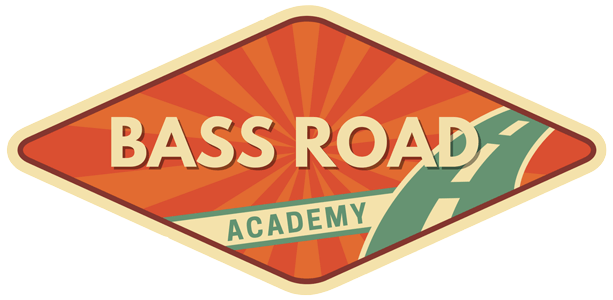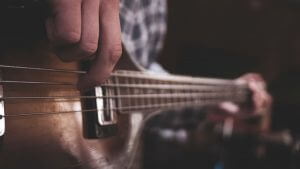Beginner Ska Bass Lines Writing Formula
In this lesson, I’ll show you how you build walking ska bass lines using a simple formula.
This works pretty much over any chord progression that get’s thrown at you.
There are few things on bass that instantly make you a superhero on stage when playing.
One of those are definitely ska bass lines, so yeah – your new superpower is making people dance.
Ska has a long tradition and in this lesson, we’ll be focusing on old-school ska and a very typical chord progression of the time.
First, here’s a listening exercise, this is what you’ll learn how to do:
Preparation & Tips For Playing Ska
When just getting started with this genre, there’s a lot to take in and it can get overwhelming fast. This is why I like to teach SKA from grounds up, starting with the earliest ska bass lines as those follow very strict building formulas.
Early ska was performed by blues and jazz bands, so there are lots of those influences in there. I guess most stereotype thing of all in ska are walking bass lines. When it comes to bass, this has stood the test of time and still today, if you plan on blasting out a ska bass line – going for a walking bass feel is the first thing you do. You want it melodic, bouncy and walking all over the place.
Here are my tips for preparing to learn how to improvise ska bass lines:
Learn the chord progression
When improvising a ska bass line, you’ll be outlining chord changes so you need to be aware of what chords are being played by the band exactly. I’ll tell you a secret when you feel lost and don’t know which notes you can play when composing a bass line. Just pick notes that are in the chord that’s played by the band – you can’t ever go wrong this way.
Play Walking Bass Rhythm
The easiest and most classic sounding is the 4 Feel walking bass rhythm. It works amazingly well for ska. This rhythm means that you are playing a pulse of straight quarter notes. So in case of 4/4 rhythm, you’ll be playing 4 quarter notes per each bar of music. Of course, you can spice this rhythm up by splitting some of those notes into 8th notes at places and such if you want.
Make sure you’re comfortable playing straight quarter notes rhythm over the backing track. If you’re a beginner, no problem! Just clap your hands to the music, those will be your quarter notes.
Use Palm Muting
We’re getting nerdy here. You can use palm muting technique to color the tone of your bass to resemble the sound of an upright bass. You don’t necessarily need to do this, but it’s a cool trick to get the sound right. I’ll be using this technique for all the examples you’re going to learn below, so listen to how it sounds in action.
Right Gear For The Job
Dress classy, you know shirt, hat, and black ‘n’ white theme going on and all LOL
Any bass guitar will do, usual recommendations are Fender Jazz or Precision for Ska with used flatwound strings. Those will sound pretty dull without too much treble, which is exactly the thing you want when emulating the sound of an upright bass.
4 Step Ska Bass Lines Building Formula
Let’s start building your first ska bass line, you know from grounds up.
It takes only 4 steps to get one going. It’s funny how learning bass can be easy with the right strategy. Anyhow, let’s get started!
Step 1: Play Root Notes
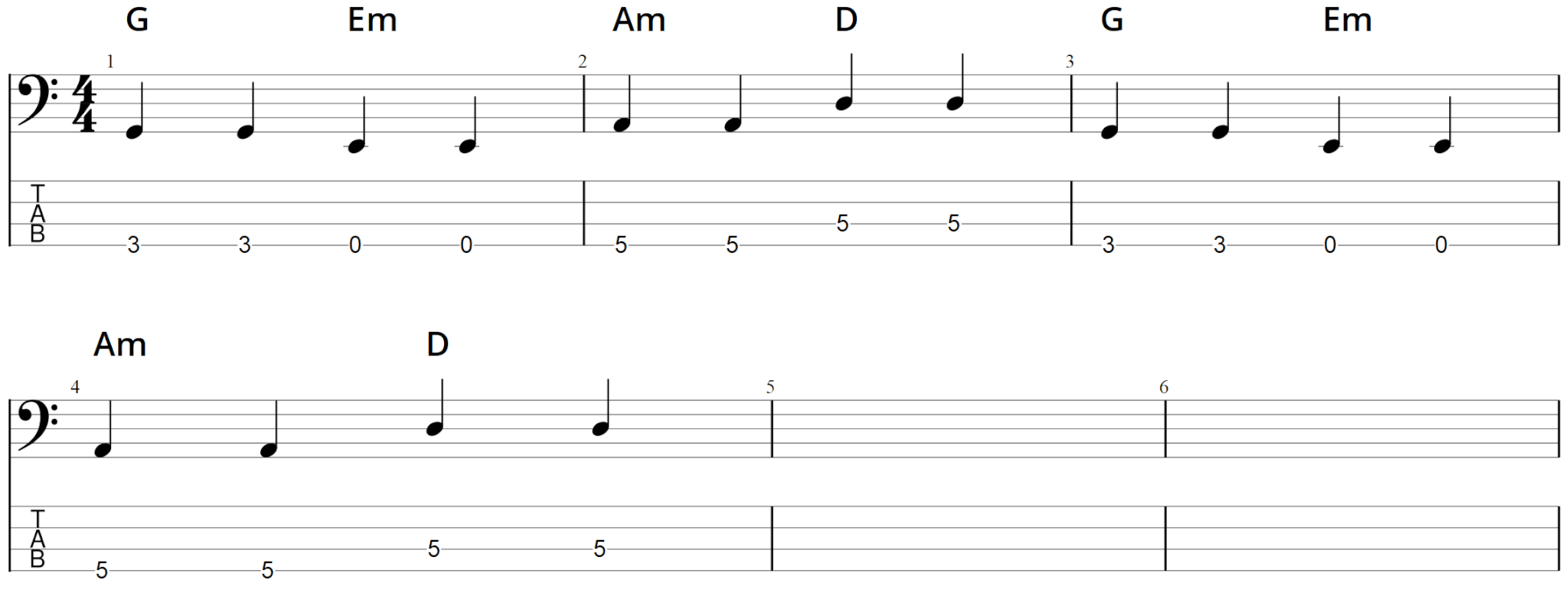
In this step I want you to play root notes of each chord in the backing track. The rhythm is classic 4 feel, which means playing 4 quarter notes per each bar. I want you to learn how to play this line by heart, because your goal here is to learn the chord progression. You want to know when each chord is being played when chord changes happen. Notice that this classic ska progression features two chords per 1 bar of music. This is a typical thing for ska to feature a chord progression like this.
Strategy for this step:
- Write down the chord progression
- Find root note on bass for each of the chords
- Play straight quarter notes rhythm
- Play root notes only, following chord changes
Backing track for practice is included in the free lesson resources package.
Step 2: Root & 5th
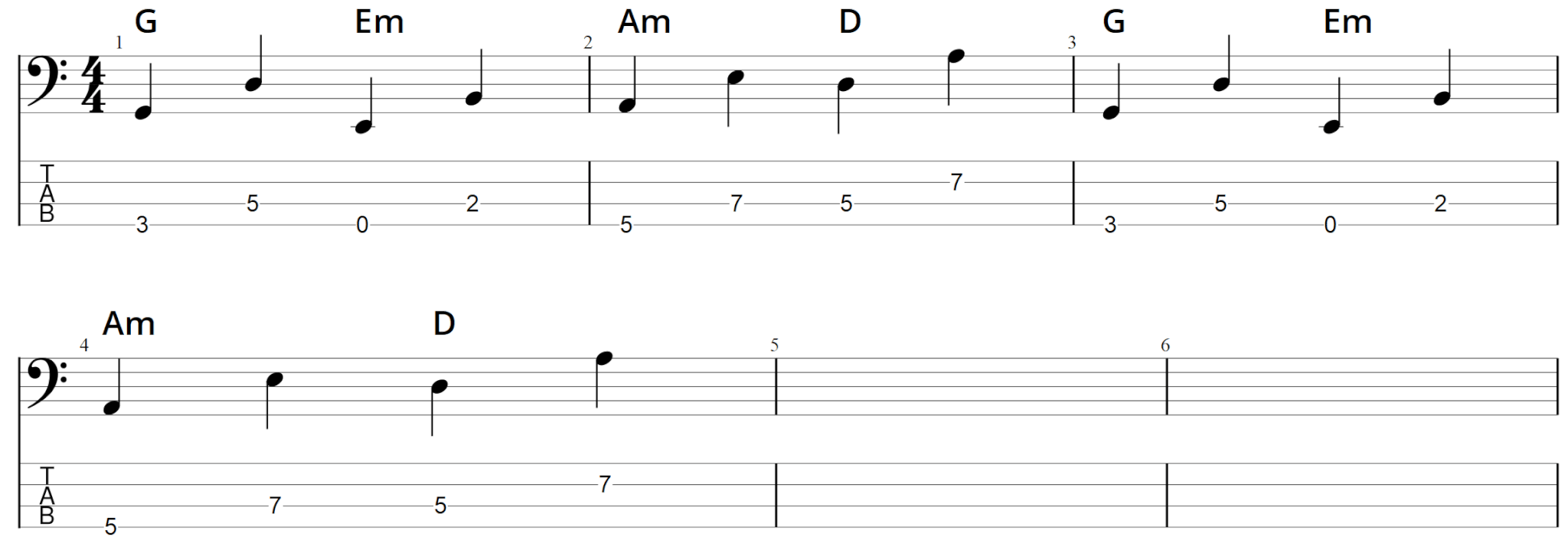
So far our formula looks like this:
R – R – R – R
R – root note
Now to spice things up, let’s add the perfect 5th internal note to the mix. Generally, you want to play the root note on ever first beat OR when chord change happens. So in our case, you’ll be playing root notes on beats 1 and 3.
There are several places on the fretboard where you can play the 5th. In this example, I’m playing it in the most standard position, just think of power chords on the guitar. So you have a root note, you go two frets to the right of it and one string below. That’s where you’ll find a 5th in relation to any root note you play on the bass neck.
With added 5th, or formula now looks like this in case of two chords per one bar of music:
R – 5 – R – 5
R – root note
5 – perfect 5th interval
Strategy for this step:
- Start by playing root notes following chord changes
- Add a 5th on beats 2 and 4
Backing track for practice is included in the free lesson resources package.
Step 3: Root & 5th Alternative Position

This time, you’ll play the 5th in another position. It’s still the same note really, just playing it in a different spot. When you fret down a root note, a perfect 5th note can also be found on the exact same fret – one string above.
I’ve composed this bass line as an exercise on how to spice things up with root & 5th as your note base. So we have roots in different positions on the fretboard than before. Learn the line and shapes used to get comfortable improvising ska bass lines this way.
The formula stays the same:
R – 5 – R – 5
Root – root note
5 – perfect 5th note
Strategy for this step:
- Start with playing root notes following chords
- Add 5th which is located above the root note on beats 2 and 4
Backing track for practice is included in the free lesson resources package.
Step 4: Improvise
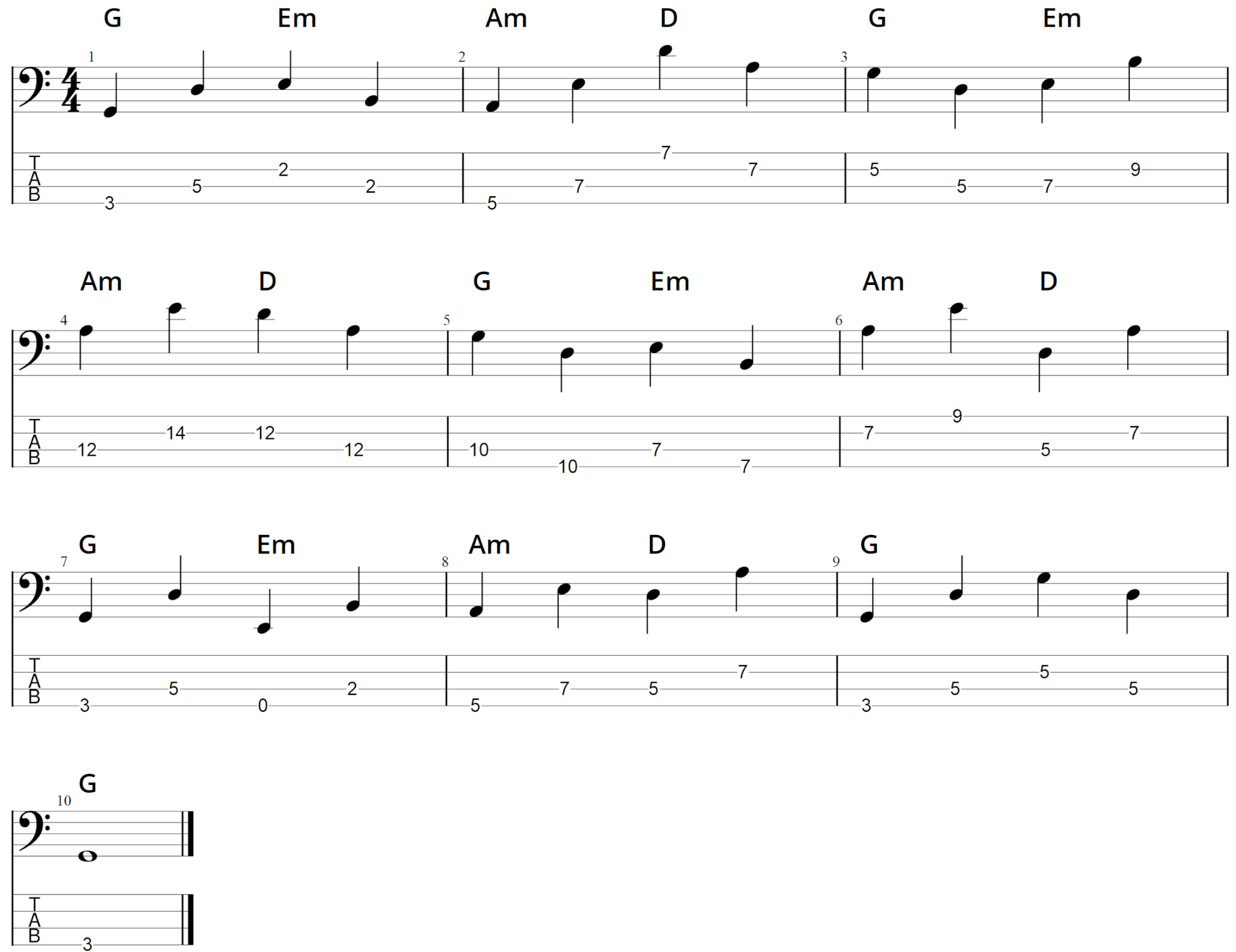
Time for the grand finale! In this bass line, you’ll mix everything up to create a nice sounding ska bass line with lots of walking bass movement to it. Funny how we can get creative with just two different notes for each chord. This is what makes improvisation amazing and so much fun.
The formula for this step still remains the same:
R – 5 – R – 5
Root – root note
5 – perfect 5th note
Strategy for building a ska bass line:
- Start by following chords in the backing track with root notes only
- Play everything in steady 4 feel rhythm
- Add perfect 5th interval note to the mix
- Change position where you play the perfect 5th note, to add variation to the line
- Explore the fretboard and experiment with finding root & 5th of each chord in different places on the bass neck
Backing track for practice is included in the free lesson resources package.
Handy Resources For Download
To help you follow the strategies I’ve covered in this lesson, I’ve created a handy free package that includes PDF that summarizes everything in this lesson PLUS you get practice backing tracks so that you can play them on your computer or living room audio system and improvise over.
DOWNLOAD LESSON RESOURCES PACK
Your Turn To Jam
Okay, now you’ve got the tools.
You’ve got the strategy.
Fire up that backing track and start practicing!
Now that you know which notes to play exactly, depending on the chord in the backing track the hard part is over. You can just let loose and improvise.
See, improvisation is not playing random notes or doodling. There are some rules and guidelines you can follow. This is why you want to study learning bass, as things like this are almost impossible to figure out on your own. You can do it, but it will take a long time to do so.
With this lesson I want you to slightly change your mindset towards realizing the importance of chord progression awareness. In plain words, you need to know which chords are being played by the band.
And not just: “you know dude, we start on G”. You want to know is it G, G minor or G7b5.
It does make a difference. That’s the first takeaway.
The second thing I want you to realize is that bass at its core is simple, and that’s okay.
You need to start with simple concepts like playing roots and 5ths as truth is – 90% of the time that’s what you’re going to play with bands in songs if you’re a good bass player.
Beginners on bass often tend to overcomplicate things. When they hear they need to improvise a bass line, they instantly think: oh I need to play more notes.
I couldn’t possibly play an easy bass line. No, you’re wrong!
If you can nail down the rhythm and all the downbeats, you’re well on your way of becoming a great bass player.
People can’t dance to a bassline that goes all over the place without being “rooted”.
Ska walking bass has some rules behind it that makes it such an amazing style of music to play on the instrument.
People dance to ska because of the very essence of the bass line which is simple yet precise, outlining chords perfectly.
That’s also what people find melodic about ska. It’s those “strong notes” you play, and guess which those notes are? Scales, nope! Those are simply notes that are already within chords played by the band.
Now, when I tell you that each chord is built from essentially only 3 different notes…Woah, right?

I’ll leave it here and it’s something we can discuss in another lesson.
Learn To Improvise SKA Bass Lines
If you want to learn how to improvise authentic SKA bass lines, check out the Early SKA Bass Lines Improvisation course:
Go here to get more information and enroll>>
It’s a structured step-by-step bass course for beginners that will introduce you to the bouncy world of SKA music.
Explore the roots of SKA and learn how to improvise SKA bass lines over ANY CHORD PROGRESSION:
Early Ska Bass Lines Improvisation Course
Suggested Bass Courses
Early SKA Bass Lines Improvisation
Learn essential SKA bass improvisation concepts and techniques. Explore the roots of this bouncy genre and learn everything you need to know to be able to blast of cool SKA bass lines over any chord progression.
Walking Bass Fundamentals
Learn to create walking bass lines using chord tones and easy strategies all bass pros know about.
If you enjoy practicing bass, there are more online bass courses & resources included in the Bass Road Academy.
These courses cover important concepts such as walking bass, blues lines, slap technique, left and right hand technique, dynamics, and so on.
It’s all carefully designed in a step-by-step manner, so you’ll know exactly what to work on from the get-go.
Go here to check out the available courses and get instant access:
Hope you’ll find this lesson helpful and that you’ll have fun improvising SKA bass lines on your own.
Keep grooving,
Bogdan
Founder, BassRoad.net
Want to get better at playing bass and make steady progress?
Level up your bass skills with online bass courses and lesson series at Bass Road Academy.
Learn why behind the bass lines you play, have a strategy when improvising and make progress faster.
